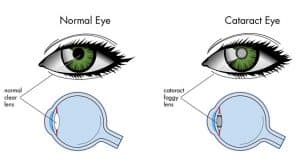The good news is there are steps you can take to help reduce your risk of cataracts, or at least delay their onset.
There is no scientific proof that cataracts can be prevented entirely, unfortunately, as we age, cataracts are simply inevitable.
Keep in mind, this is only a guide, and should not be a substitute for medical advice from your eye doctor.
Contact and eye doctor near you to discuss all options for diagnosis and management of cataracts.
Most cataracts develop as a result of aging, though research has shown that certain factors can increase your risk of developing a cataract.
Many of these risk factors include:
- Smoking
- Alcohol
- Obesity
- Diabetes
- Hypertension
- Ultraviolet (UV) light
- Steroids or statin medications
- Eye injury or eye surgery
- Nutritional deficiency
By making some lifestyle changes, you may be able to lower your risk of cataracts.
Eat a healthy diet
Your diet and the foods you consume are your choice alone. By eating a healthy diet, including the necessary vitamins and nutrients your body craves, you are not only reducing your risk of cataracts, but also helping your body remain healthy and strong.
Research has shown that eating foods that contain the healthy vitamins C and E, and lutein and zeaxanthin, may reduce your risk of cataracts.
Additionally, if you already have cataracts, these vitamins and nutrients may slow their progression.
1. Vitamin C
Vitamin C (ascorbic acid) is an antioxidant that is highly concentrated in the aqueous humor of the eye— and is directly linked to dietary intake. By increasing vitamin C in your diet, you can increase the vitamin C concentration in your eyes.
Research suggests that a daily dose of 300mg of vitamin C is associated with a lower risk of developing cataracts.
Which foods contain vitamin C?
- Bell peppers
- Citrus fruits
- Kale
- Broccoli
- Guava
2. Vitamin E
Vitamin E is a fat-soluble antioxidant that protects the fatty acids in the eyes from free radicals, or harmful chemicals, which damage healthy eye tissue.
Which foods contain vitamin E?
- Tree nuts
- Peanuts
- Sunflower seeds
- Vegetable oils
- Green leafy vegetables
3. Lutein and zeaxanthin
Lutein and zeaxanthin are potent antioxidants that offer many health benefits, though they are best known for protecting your eyes from the sun’s UV rays and harmful blue light.
Many studies have shown that these nutrients are associated with a reduced risk of chronic eye diseases, including cataracts, age-related macular degeneration (AMD), retinal detachment, diabetic retinopathy, and uveitis.
- Low levels of lutein and zeaxanthin are associated with cataracts, while higher levels may reduce risk of developing cataracts.
- According to research, consuming 6-20 mg of lutein and zeaxanthin per day can significantly reduce your risk of ocular conditions.
Which foods contain lutein and zeaxanthin?
- Spinach
- Swiss chard
- Kale
- Parsley
- Pistachios
- Green peas
- Egg yolks
- Sweet corn
- Red grapes
Keep in mind, carotenoids are absorbed better when eaten together with fat— so when eating these nutrient rich foods, add some olive oil or avocado to your plate!
Eating five servings of fruits and vegetables every day will ensure that you are getting the right amount of vitamin C, and lutein and zeaxanthin. Add two servings of nuts for an adequate amount of vitamin E, and you will be on your way to lowering your risk of cataracts.
Some may find it difficult to consume a sufficient amount of vitamins and nutrients on a daily basis. In this case, ask your doctor about adding multivitamins and supplements to your daily regimen.
If you have cataracts, contact an eye doctor near you, who can diagnose and discuss the best treatment options.
SEE RELATED: What are Cataracts?
Quit Smoking
While smoking is a serious risk factor for many harmful diseases, it can also increase your risk of cataracts.
Smoking increases the amount of free radicals in your eyes. Superoxide and hydroxyl radicals damage the lipids and proteins in the eyes. This causes deposits to form on the surface of the eye’s lens, and leads to opacities, or cataracts. While the antioxidants you consume help to fight the free radicals, smoking can actually kill off the antioxidants and produce toxins that lead to cataracts.
Therefore, if you quit smoking, you may be able to prevent cataracts— even if you’ve been a habitual smoker for years.
Wear sunglasses
Sunglasses are not only fashionable and stylish, they also protect your eyes. Prolonged exposure to the sun’s harmful UV rays can increase your risk of cataracts, as they damage the proteins in the lens of your eye.
When shopping for a new pair of shades, make sure they:
- Block out 99% to 100% of UVA and UVB rays
- Filter out 75% to 90% of visible blue light
- Are large enough to protect your eyes from all sides
Limit alcohol
Studies have shown that drinking too much alcohol can increase your risk of cataracts. Alcohol increases your body’s inflammatory response, and the production of free radicals in your eyes. It also leads to dehydrating effects, which can impact the proteins in your eye’s lens.
Don’t worry, we won’t ask you to give up your favorite drink completely— just try to limit your alcoholic beverages to one drink per day.
Research has shown that consuming more than this recommended amount can increase your risk of cataracts by up to 11 percent.
Maintain healthy blood sugar level
People who have diabetes are more likely to develop cataracts, especially if blood sugar levels are not controlled.
This is mainly true, because if your blood sugar level remains too high for too long, your eye lens will begin to swell and convert blood sugar into sorbitol. When sorbitol collects in your eye’s lens, visual distortion will occur, and a cataract may develop.
Avoid corticosteroid medications
Long-term use of prednisone and other oral steroids that are prescribed for severe allergies, arthritis, blood disorders, and other medical conditions, have been shown to increase the risk of cataracts.
Corticosteroids have anti-inflammatory properties that can affect both your eyes and vision, and cause a posterior subcapsular cataract. This type of cataract occurs when a small, cloudy area forms underneath the eye’s lens.
In general, the higher the dose of steroids, or the longer you take them, the higher your risk of developing cataracts. However, if you have been prescribed a course of steroid treatments, don’t panic— your doctor has weighed the benefits and risks of the medication, for your individual circumstance.
Schedule regular eye exams
Regular comprehensive eye exams are essential for maintaining your ocular health. Your eye doctor can detect any changes or disturbances in your vision or ocular health, even before symptoms are noticed.
Eye doctors recommend that between the ages of 40 and 64 you should have an eye exam every two to four years. If you are over age 65, your eye exams should be every one to two years, at most.
LEARN MORE: Guide to Eye Conditions
Schedule an appointment with an eye doctor for a comprehensive eye exam, and to discuss any questions you may have about your cataracts.
If you are concerned about developing cataracts, you are not alone. By adjusting some important factors in your life, you can lower your risk of cataracts, and can rest assured that you are doing everything in your power to protect your ocular health.









